ARCHIVE · 2016
FRANCIS BACON: The Boundaries of the Mind
22.12.2016 - 26.2.2017
Author of the exhibition: Vesna Delić Gozze
The independent painterly topology of metaphysics arising out of Bacon's idea of the brutality of fact and the phantom presence close to the photographic technique that this painter often used as an original in his work, turning it into the main support in the creation of a provocative word of paintings and drawings is far from the steretype of the moribund traditional code of aestheticisation. Bacon's image is dystopian, and when there in it is not specific ontology of violence, it is still terrifying from the loss of illusion about the identity of the figures. Still, from the example of a series of Bacon's drawings, the input of irony is along the lines of surrealist automatism of creation and shows solacing figures of the human wish for change and the possibility of the victory of Good through the painter's fragile equilibrium of a diffuse world of incessant change.
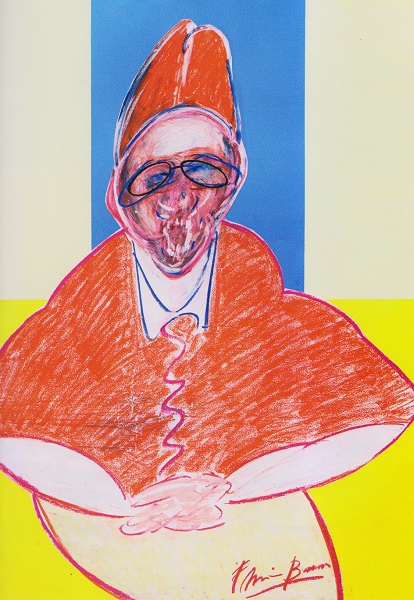
Francis Bacon: Pope, pastel on paper
It is true, of course; the Pope is unique. He's put in a unique position by being the Pope, and therefore, like in certain great tragedies, he's as though raised on to a dais on which the grandeur of this image can be displayed to the world.
Francis Bacon
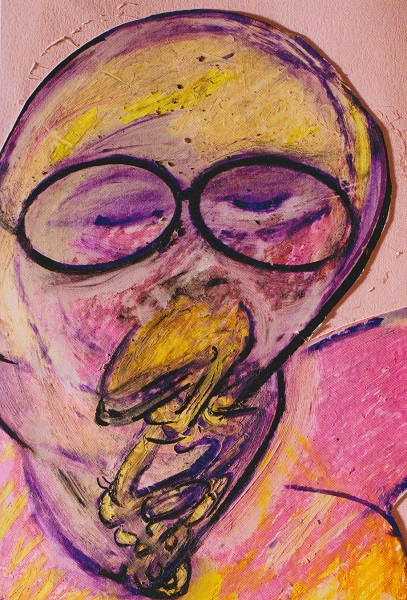
Francis Bacon: Self-portrait. pastel and collage on paper
The deformed physiognomies, the unnatural positions of the limbs seen at once from various perspectives that are it were testing out the borders of connection with the body, the emphasised facial expressions the shrieks from which continue in the nearby brush or pencil strokes and explode in the graphism of the forces, showing the completely personal expression and vibration of just vented aggression.
Vesna Delić Gozze
Orenburg, čipkarska svjetska baština
17.12.2016. - 29.1.2017.
Izložba Orenburg, čipkarska svjetska baština otvorena je u Atelijeru Pulitika u subotu, 17. prosinca, a nastala je u suradnji Umjetničke galerije Dubrovnik i Umjetničkog muzeja Orenburg iz Rusije. Posjetitelji suosim jedinstvene prilike upoznavanja sa ovim dijelom ruskog kulturnog nasljeđa, najsjajnijim draguljem kulturne riznice Orenburga, u izvedbi Hrvatsko - ruskog društva "Umjetnost bez granica" mogli poslušati i izvornu rusku glazbu.

Izložbenom djelatnošću i promicanjem umjetnosti stepskih predilja aktivno se bavi Umjetnički muzej Orenburg, koji posjeduje za Rusiju jedinstvenu kolekciju orenburških marama od pahuljaste vune. Samo proteklih godina (2010. – 2016.) s izložbom su se upoznali posjetioci iz Švicarske, Danske, Španjolske, Njemačke, Malte, Češke, Italije, Engleske, Norveške i Nepala.
Postojanje već 200 godina poznate Orenburške marame od pahuljaste vune dokazuje da je navedeni umjetnički rad toliko prirodan za Orenburg koliko i šivanje od jelenjeg krzna za Sjever ili keramika za srednju Aziju. Marama se pojavila u kozačkim naseljima, među ruskim doseljenicima, te kao djelo kolektivnog narodnog stvaralaštva priča priču o povijesnom okruženju, socijalno-ekonomskim i trgovačkim odnosima, jedinstvenim prirodnim bogatstvima te lokalnom načinu života.

U današnje vrijeme, kao i prije mnogo godina, predilje predu marame po sjećanju. Njima nisu potrebni crteži ili unaprijed napravljene sheme. Osnove tkanja ažurnih marama poznate su im u tančine. Izrada marama, na taj način postaje umjetničkim procesom, u kojem se na osnovi varijacija tradicionalnih vezenih elemenata svaki put rađa unikatan i jedinstven rad. U procesu izrade marama upotrebljavaju se klasične metode poznate u cijelom svijetu – crtež ažurnog tkanja stvara se uz pomoć pravog boda i jednostavnih navoja. Kroz stoljeća su se orenburški uzorci rađali i usavršavali. Danas postoji prepoznatljiv i jedinstven sistem motiva i uzoraka. On i objedinjuje svu umjetnost orenburškog tkanja, te njegove umjetničke i tehničke tradicije.
Europska se publika s orenburškim maramama prvi put upoznala 1851. godine na prvoj Svjetskoj izložbi u Londonu. Već su tada marame skrenule pažnju na sebe te dobile posebne nagrade. 1862. na drugoj Svjetskoj izložbi u Londonu Kozakinji iz Orenburga, Mariji Uskovoj, bila je dodijeljena medalja „Za marame od kozjeg paperja“. Godine 1897. orenburške marame su dobile medalju u Chicagu, 1958. – veliku srebrenu medalju na Svjetskoj izložbi u Brisselu. Također su se orenburške marame izlagale na svjetskim izložbama u Kanadi (Montréal, 1967.) i Japanu (Tokio, 1968.), na međunarodnim sajmovima u Alžiru (1969.), Siriji ( 1975.), Grčkoj (1976.), Francuskoj ( 1977.), Engleskoj ( 1979.), Austriji (1980.), Španjolskoj (1981.), Indiji (1982.), Njemačkoj (1985.) itd.
Izložba SLIKARI DOŠLJACI 1938.-1945.
Iz fundusa Umjetničke galerije Dubrovnik
16.12.2016. - 29.1.2017.
Kustosica izložba: dr.sc. Rozana Vojvoda

Hans Gassebner, Pejzaž s tri kuće (Zaton), 1942. g., akvarel, papir, 37 x 50 cm, inv. br. UGD-1081

Hans Gassebner, Pejzaž s čempresima, 1941. g., akvarel, papir, 30 x 44,5 cm, inv. br. UGD-1092
Izložba “Slikari došljaci 1938.-1945.” otvorit će se u petak, 16. prosinca u 18 sati u Galeriji Dulčić Masle Pulitika. Izložba predstavlja izbor od od četrdesetak crteža, akvarela, pastela i ulja na platnu datiranih u rasponu od 1938.-1945. godine, koji se čuvaju u fundusu Umjetničke galerije Dubrovnik.

Willy Hempel, Masline, tempera, papir, 36,5 x 50 cm, inv. br. UGD-1094
Većina djela došla je u Umjetničku galeriju Dubrovnik kao dio zbirke Zaloni, ostavštine Artura Zalonija, koju je djelomično otkupila Umjetnička galerija Dubrovnik 1979. godine. Predstavljeni autori Hans Gassebner (1902.-1966.), Franz Schaffgotsch (1902.-1942.), Carl Johann Rabus (1898.– 1983.), Willy Hempel (1905.-1985.), Walter Hoefner (1903.-1968.) i František Besperato (1900.-1963.) su od ranih tridesetih do sredine četrdesetih godina dvadesetog stoljeća boravili na dubrovačkom području i šire. U većini slučajeva su emigrirali pred nacističkom opasnošću, a od strane njemačkog nacističkog režima svrstani su u kategoriju „degenerativne / izopačene“ umjetnosti koja je zapravo označavala modernu / avangardnu umjetnost sa svim svojim pravcima.

Walter Höfner, Muškarac i žena, 1941. g., pastel, papir, 34,9 x 45,7 cm, inv. br. UGD-1099

Walter Höfner, Za stolom, 1937. g., tempera, papir, 47,6 x 63 cm, inv. br. UGD-1178
Izložba je prvi korak u revalorizaciji ostavštine manje poznatih stranih umjetnika koji su boravili na dubrovačkom području u smislu daljnjeg istraživanja njihovog opusa, istraživanja interakcije s domaćim umjetnicima, te detektiranje boravka onih umjetnika koji se do sada nisu spominjali u stručnoj literaturi.

Franz Schaffgotch, U Aleksandrijskoj luci, 1939. g., tempera, papir, 21 x 34 cm, inv. br. UGD-1220

Franz Schaffgotch, Haifa, 1939. g., tempera, papir, 21 x 34 cm, inv. br. UGD-1221
U zbirci Umjetničke galerije Dubrovnik čuva se šezdesetak djela međunarodnih autora koji su od ranih tridesetih do sredine četrdesetih godina dvadesetog stoljeća boravili na dubrovačkom području i šire. Riječ je mahom o akademskim slikarima raznih nacionalnosti - Nijemcima, Austrijancima, Česima i Poljacima, čiji su razlozi za boravak na spomenutim prostorima različiti, ali se najčešće može govoriti o emigraciji pred nacističkom opasnošću. Većina djela došla je u Umjetničku galeriju Dubrovnik kao dio zbirke Zaloni, ostavštine Artura Zalonija, koju je djelomično otkupila Umjetnička galerija Dubrovnik 1979. godine.
Ovom prilikom prvi puta se prikazuje izbor od četrdesetak djela manje poznatih stranih autora datiranih u rasponu od 1938.-1945. godine, koji uključuje radove Hansa Gassebnera
Franza Schaffgotscha, Carla Johanna Rabusa, Willyja Hempela, Waltera Hoefnera i Františeka Besperata. Gotovo svi ovi umjetnici svrstani su od strane njemačkog nacističkog režima u kategoriju „degenerativne / izopačene“ umjetnosti koja je zapravo označavala modernu / avangardnu umjetnost sa svim svojim pravcima (ekspresionizam, kubizam, nadrealizam..).
BIOGRAFIJE:
Walter Hoefner (1903.-1968.), student klase Karla Hofera na berlinskoj Akademiji likovnih umjetnosti, oko 1934. je napustio Njemačku da bi utočište našao na Korčuli. Izlagao je 1938. godine na „Izložbi njemačke umjetnosti dvadesetog stoljeća“, čiji je prihod bio namijenjen slikarima emigrantima, te je u to vrijeme najvjerojatnije posjetio Veliku Britaniju. Ponovno se vraća na Korčulu gdje je preživljavao od slikanja i fizičkog rada i gdje je ostao barem do 1944. godine, sudeći po dataciji crteža. Izgleda da je davao i neformalne poduke, jer je poznat podatak da je od 1938.-1939. godine podučavao češkog slikara Josefa Istlera. (1919. – 2000.). Većina Hoefnerovih radova koji se čuvaju u Umjetničkoj galeriji Dubrovnik crteži su tušem, pasteli i akvareli rađeni na nekvalitetnom papiru koji signalizira loše materijalne uvjete u kojima je radio. U pejzažima i vedutama rađenim akvarelom ili pastelom pokazuje izuzetnu crtačku finoću i prijemčljivost za svjetlosne efekte, dok skice pojedinih muškaraca u kavanama ili grupne kompozicije (primjerice Za stolom iz 1937. godine) pokazuju njegov ekspresionistički habitus u iskrzanom, valovitom crtežu i uznemirujućem naboju prizora.
Grof Franz Schaffgotsch (1902.-1942.) je austrijski slikar i grafičar, te ilustrator knjiga, koji je zajedno sa suprugom emigrirao 1938. godine prvo na Rab, a potom u Zagreb i čiji je život na dubrovačkom području najbolje dokumentiran zahvaljujući dragocjenim memoarima njegove žene Hedwige Schaffgotsch (Putovima sudbine,Zagreb: Hrvatsko-austrijsko društvo, 2009.)
U Dubrovnik stižu 5.6. 1939. godine, gdje se ubrzo nastanjuju na otoku Šipanu i tamo ostaju sve do 1942. godine i hapšenja od strane tadašnje vlasti. Franz Schaffgotsch umire u Dubrovniku 21.12. 1942. godine te je pokopan u grobnici obitelji Wregg na lapadskom groblju Sv. Mihajla.
Na izložbi je predstavljen serijom tempera i tuševa s egzotičnog putovanja na relaciji
Pirej-Atena-Aleksandrija-Haifa-Dubrovnik, koje je radio za brodsku kompaniju u zamjenu za troškove putovanja te koje je dovršavao u Dubrovniku. Dopadljivi radovi s izraženom ilustrativnom komponentom ne pokazuju ni u naznakama ekspresionistički senzibilitet karakterističan za njegove rane radove. Svojom pročišćenom jednostavnošću u kadriranju i lucidnim odabirom boja te gotovo stripovskim senzibilitetom (osobito u crtežima tušem) odmiču se od bilo kakve naznake kiča u koji bi se odabirom teme / zadatka moglo zapasti. Zanimljivost je da je crno-bijele crteže Schaffgotsch radio s crnilom od sipe u peru, a zbog prelaženja vlažnim prstom po još mokroj tinti, supruga je te crteže nazivala radovima “u pljuvačkoj tehnici”.
Hans Gassebner (1902.-1966.) je je oko 1933. godine emigrirao iz Njemačke, a 1936. se preselio u Zaton Mali kraj Dubrovnika gdje ostaje negdje do 1945./1946. godine kada se vraća u Njemačku u blizinu Stuttgarta, te sljedeće godine seli u Ulm. Muzej u Ulmu mu izdaje monografiju te je zapravo njegovo stvaralaštvo najbolje dokumentirano od autora prisutnih na izložbi. Na izložbi je predstavljen pejzažima i prikazima životinja i upravo se u srazu tih, naizgled pastoralnih motiva i ekspresionističkog slikarskog oblikovanja silovitim potezima kistom i gustim nanosima boja u reduciranoj skali stvara dojam neke neobične napetosti. Pejzaži nemaju niti natruhe arkadijske komponente, već je cijeli konstruirani slikarski prostor uzbiban, uznemiren. Ovce na pašnjacima djeluju izgladnjelo i otužno, a prizori sa seljankama umjesto idiličnog suživota s prirodom odašilju neku čudnu agoniju vidljivu u govoru tijela i grimasama lica.
Carl Johann Rabus (1898.-1983.), ekspresionistički slikar i ilustrator knjiga i časopisa, studirao je na minhenskoj Akademiji likovnih umjetnosti u klasi Angela Janka. Njegov boravak u Dubrovniku još treba dodatno istražiti, ali s obzirom na motiv broda u gradskom portu kojim se predstavlja na izložbi i činjenicu da su svi autori iz zbirke Zaloni uistinu boravili na dubrovačkom području, postoje dobre pretpostavke za to.
Willy Hempel (1905.-1985.) je studirao od 1927.-1929. godine na Akademiji likovnih umjetnosti u Königsbergu, a potom preselio u Berlin gdje je radio kao slobodni umjetnik, emigrirao je oko 1933. godine, ali ostaje za istražiti kada je točno došao u Dubrovnik i koliko je ostao. Poznato je da je 1949. godine zajedno s umjetnicima Willijem Baumeisterom i Rolfom Cavaelom bio suosnivač grupe «Zen 49», koja je pokrenuta u Münchhenu u Galeriji Otto Stangl. Na izložbi je predstavljen s crtežom i dva pejzaža, a jedan od njih «Masline» u svom razlaganju i umnažanju biljnih formi anticipira Hempelov kasniji postkubistički izraz.
František Besperato (?1896.-1963.) (Francesco Pablo de Besperato i Francesco Paulo de Besperato su varijante imena koje umjetnik koristi) je studirao na Akademiji likovnih umjetnosti U Pragu (gdje mu je jedno vrijeme profesor bio i Vlaho Bukovac), te na Akademiji likovnih umjetnosti u Münchenu.
Napustio je Čehoslovačku 1928. godine, te je došao u Zagreb, potom u Split, na Rab i Hvar i negdje oko 1929. godine u Dubrovnik. U Dubrovniku se bavio restauracijom, a dobijao je i narudžbe. Iz dubrovačkog kulturnog kruga, družio se s Kostom Strajnićem, Markom Muratom, raznim dubrovačkim slikarima, a osobito sa slikarom Gabrom Rajčevićem, koji ga je u dva navrata portretirao.
GRGUR AKRAP
FEDOR FISCHER
17.11.-18.12.2016.
Kustos: Feđa Gavrilović
Kustos organizator: Vesna Delić Gozze

Grgur Akrap, Neželjeni gost, 2016., ulje i enkaustika na platnu, 86 x 70 cm
Izložba dvojice slikara zagrebačkog kruga Fedora Fischera i Grgura Akrapa bit će otvorena u Umjetničkoj galeriji Dubrovnik u četvrtak, 17. studenoga u 19 sati, a predstavit će njihove radove iz posljednjih godina. Ono što spaja ova dva umjetnika mlađe i srednje generacije je materičan odnos prema slikarstvu, naglasak na impastu boje, stvaranje slika zasićenih pigmentom i gustim nanosima.

Fedor Fischer, Kolaps I, 2016., kombinirana tehnika, platno, 200 x 250 cm
Kustos izložbe, povjesničar umjetnosti Feđa Gavrilović za umjetnike je u katalogu zapisao: „Oba autora opće slikom i sa slikom. Oni je tretiraju kao živ medij: s njome su u fizičkoj i intenzivnoj interakciji, uronjeni u njezino tijelo u potrazi za ostvarenjem svoga izraza, svoje vizije savršenstva, ali i otpora svim drugim vizijama. Također, ona je i sredstvo kojim pokušavaju uputiti gledatelja u svoju stvaralačku intimu, odnosno pozvati ga da sudjeluje u njoj, da je upije fizički, estetski ili intelektualno – kako god mu je drago.”

Grgur Akrap, Relikvija, 2016., ulje i enkaustika na platnu, 150 x 160 cm
Kustosica izložbe, Vesna Delić Gozze za Fischera je u katalogu zapisala: „ Ako prihvatimo tezu da apstraktno stvaralaštvo u doslovnom smislu ne postoji jer je svako slikarstvo prikazivanje nečega, radovi Fedora Fischera na ovoj izložbi svjedoče da izvanjski svijet prepoznatljivih koordinata “neapstraktnoga” još ne legitimiraju likovno stvaranje kao figuraciju, jer bi se i detalj iz izvanjskog svijeta uvećan do neprepoznatljivosti svojeg izvorišta i predloška svrstao po klasičnoj nomenklaturi u apstrakciju.”, dok je za Akrapov rad između ostaloga zapisala: „Ljudska figura u Akrapa je dominantan motiv, a kao kod niza suvremenih likovnih autora, ovaj slikar na posredan način izražava svu nesigurnost ontološkog statusa čovjeka.”

Fedor Fischer, Kolaps II, 2016., kombinirana tehnika, platno, 200 x 250 cm
Biografija – Grgur Akrap
Grgur Akrap rođen je 1988. u Zagrebu. Diplomirao je 2013. godine na Nastavničkom odsjeku Akademije likovnih umjetnosti u Zagrebu u klasi prof. Damira Sokića. Član je Hrvatskog društva likovnih umjetnika od 2012. godine. Izlagao je na samostalnim i skupnim izložbama. Dobitnik je: priznanja Akademije likovnih umjetnosti u Zagrebu za uspjeh u cjelogodišnjem studiranju i najbolji diplomski rad (2013.); nagrade ULS Zaprešić za minijature iz ciklusa Ukradeni portreti na izložbi 16. Minijature i nagrade natječaja ENERGIJA 2012. (2012.) u organizaciji INA-e, Zagreb. Umjetnikov rad Ecce homo odabran 2011. godine kao jedan od najboljih radova nastavničkog smjera ALU akademske godine 2010./2011.
.jpg)
Grgur Akrap, Ritual, 2016., ulje i enkaustika na platnu 94 x 50 cm
Biografija – Fedor Fischer
Fedor Fischer rođen je 1975. godine u Zemunu. Diplomirao je slikarstvo na Akademiji likovne umjetnosti u Zagrebu 2007. godine u klasi prof. Zlatka Kesera. Radovi mu su nalaze u zbirci Erste& Steiermarkische banke u Hrvatskoj i u Okolje Consulting Art Collection u Sloveniji. Izlagao je na više samostalnih i skupnih izložbi. Član je Hrvatskog društva likovnih umjetnika. Živi i radi u Zagrebu.
%20I,%20Mixed%20Media,%20180%20x%20225%20cm,%202016.jpg)
Fedor Fischer, Potisak, 2016., kombinirana tehnika, platno, 180 x 225 cm
IVAN PICELJ 1951.-2011.
10.11. - 11.12.2016.
Ivan Picelj, Cy-Blu, 1971., vlasništvo: Muzej moderne i suvremene umjetnosti Rijeka
Izložba naziva Ivan Picelj 1951.-2011., poznatog hrvatskog umjetnika Ivana Picelja bit će otvorena u Galeriji Dulčić Masle Pulitika i Atelijeru Pulitika u četvrtak, 10. studenoga u 19 sati. Izložba je nastala u suradnji sa Muzejem – Museo Lapidarium u Noivigradu i Narodnim muzejem Crne Gore na Cetinju.

 Ivan Picelj, Cyclophoria 5, 1971., sitotisak, privatno vlasništvo
Ivan Picelj, Cyclophoria 5, 1971., sitotisak, privatno vlasništvo
Kustosica izložbe, Jerica Ziherl, za Piceljev rad je u izložbenom katalogu između ostaloga zapisala: “Objektivnost rada, pristajanje na mjesto sudionika u operativnim grupama ili pokretima, čuvajući pritom mjeru vlastite slobode, identiteta, izbora i odluka, one su vrijednosti koje su činile Ivana Picelja toliko različitim i posebnim od drugih istodobnih ili prethodnih umjetničkih osobnosti.”
Za Piceljevo stvaralaštvo, Brane Kovič, autor teksta u katalogu je zapisao: “Tipološki model koji je uskoro postao nedvosmisleni distinktivni znak Piceljeva polivalentnog stvaralaštva, svoju je uvjerljivu potvrdu doživio umjetnikovim prijelazom na istraživanje programiranih varijacija i modifikacija elementarnih geometrijskih formi. Između prvih manifestacija te autorske odluke svakako je grafička mapa Oeuvre programmée No. 1 u nakladi pariške galerije Denise René 1966. godine, a može se smatrati početkom tematskoga niza koji se tijekom sljedećih godina i desetljeća ostvarivao u novim edicijama, pažljivo promišljenim i vrhunski izvedenim mapama u sitotisku od kojih je svaka dovršena cjelina, a ujedno je svaki list savršeni likovni organizam.”
 Površina dLN7, 2005.; metal, boja; privatno vlasništvo
Površina dLN7, 2005.; metal, boja; privatno vlasništvo
Biografija:
Ivan Picelj (Okučani, 1924. – Zagreb, 2011.) jedan je od najuglednijih hrvatskih umjetnika međunarodne reputacije koji je svoj likovni izričaj uspješno ostvarivao u različitim medijima. Njegov se svjetonazor izražavao specifičnom i osobnom egzaktnom imaginacijom dosljedno očitovanom u brojnim područjima i disciplinama – u slikarstvu, objektima, reljefima, grafici, oblikovanju, tipografiji i crtežima. Bio je pionirom geometrijske apstrakcije na kulturnim prostorima tadašnje Jugoslavije, a posebno je istaknut njegov doprinos na području grafičkog oblikovanja i razvoju vizualne kulture. Studirao je na Akademiji likovnih umjetnosti u Zagrebu između 1943. i 1946., kada napušta studij i počinje stvarati kao samostalan umjetnik. Još tijekom studija osnovao je s Aleksandrom Srnecom i Ivanom Kalinom grupu IPIKAS, a umjetničko djelovanje započinje od 1948., kada u suradnji s Vjenceslavom Richterom i Aleksandrom Srnecom, kasnije i sa Zvonimirom Radićem, radi na postavu umjetničkih, didaktičkih i gospodarskih izložbi te sudjeluje u projektiranju i realizaciji jugoslavenskih izložbenih paviljona za svjetske sajmove u Stockholmu, Beču, Hannoveru, Torinu, Chicagu i Parizu. Godine 1951. sa slikarima i arhitektima osniva grupu EXAT 51 (Eksperimentalni atelje 51). Od 1954., osnivanjem Gradske galerije suvremene umjetnosti u Zagrebu (danas Muzej suvremene umjetnosti), započinje dugogodišnja suradnja te institucije s Piceljom. Godine 1955. sudjeluje u organizaciji prve izložbe industrijskog dizajna u Zagrebu, a godinu dana poslije bio je i jedan od osnivača Studija za industrijsko oblikovanje (SIO). Tijekom tih desetljeća Ivan Picelj oblikovao je brojne publikacije, kao što su knjige u nakladi Grafičkog zavoda Hrvatske, Matice hrvatske i nakladničke kuće Znanje. Oblikovao je i niz plakata uglavnom za muzejske i glazbene institucije u Zagrebu. Isto je tako oblikovao logotipove i znakove te je grafički uređivao revije, časopise i prospekte – ukratko, zaslužan je za pionirsku ulogu promicanja nove estetike oblikovanja u Hrvatskoj. Picelj 1960-ih godina usvaja suvremenu grafičku tehniku svilotiska i jedan je od najistaknutijih članova unutar tzv. zagrebačke škole serigrafije. Autor je brojnih grafičkih mapa. Također početkom 1960-ih, uz Almira Mavigniera i Božu Becka, bio je jedan od glavnih utemeljitelja pokreta Novih tendencija – niza međunarodnih izložbi konstruktivne i kinetičke umjetnosti u zagrebačkoj Galeriji suvremene umjetnosti (1961.–1973.). Svojim slikarskim, grafičkim i grafičko-tipografskim segmentima dizajnerskoga opusa Picelj je na mlađe generacije hrvatskih umjetnika prenio postulate neokonstruktivizma, estetike Bauhausa, minimalizma i konceptualnih istraživanja. Povodom umjetnikova šezdesetogodišnjega djelovanja na hrvatskoj i inozemnoj likovnoj sceni Hrvatska pošta 2006. izdaje marku s njegovim ranim radom Kompozicija Tyma 3 iz 1959./1960. U popratnom tekstu navode da je Ivan Picelj jedan od najvećih boraca za dostojanstvo i inventivnost geometrijske apstrakcije na europskim prostorima. Izlagao je u brojnim međunarodno priznatim izložbenim institucijama u zemlji i svijetu.
EUGEN KRSTULOVIĆ (1912. – 1976.)
akvareli, ulja
14.10.-6.11.2016.
Izložba Eugena Krstulovića (1912.-1976.), splitskog, ali prvenstveno dubrovačkog slikara, otvorit će se u petak, 14. listopada u 19 sati u Galeriji Dulčić Masle Pulitika i Atelijeru Pulitika.
Na izložbi koja revalorizira stvaralaštvo ovog nepravedno zapostavljenog umjetnika bit će izloženi akvareli i ulja, uglavnom u vlasništvu obitelji Krstulović iz Dubrovnika, te nekoliko radova iz zbirke Umjetničke galerije Dubrovnik. Autor izložbe je renomirani povjesničar umjetnosti Nikola Albaneže, koji je u predgovoru kataloga, između ostalog zapisao ove retke: “Po vremenu svoga dolaska u Dubrovnik (u ljeto 1949. godine), Krstulović bi pripadao trećem naraštaju slikara (premda stariji od Dulčića, Masle i Pulitike) kojima je snažni kolorizam bitno nagnuće. Međutim, i to je osobito zanimljivo, njegova se posebnost u najvažnijem segmentu opusa upravo na planu te srodnosti i zajedničkih karakteristika – zavičajna motivika, likovna morfologija, kromatska eksplozivnost - jasno izdvaja. Izdvaja se po lapidarnosti izraza koji je dosegao stenografsku lakoću i pregnantnost, po prednosti koju je davao tehnici akvarela (možda i ne po svojoj želji jer ga je bolest primorala na takvu odluku), napokon i po osobitoj životnoj radosti koja prevladava iz cjeline opusa.”


BIOGRAFIJA
Eugen Krstulović je rođen u Splitu 6. prosinca 1912. godine. U rodnome je gradu stekao prve poduke iz slikarstva i kiparstva na Srednjoj tehničkoj školi kao đak Emanuela Vidovića i Svitoslava Mihaela Peruzzija. Na zagrebačkoj Akademiji likovnih umjetnosti student je slikarstva 1930. – 1934. (diplomira u klasi profesora Ljube Babića), ali i kiparstva 1934. – 1938. (studij završava kod profesora Frana Kršinića). Nakon odsluženja vojnog roka radi kao nastavnik crtanja u Korenici 1940./41. i Krku 1941/42. U Drugome svjetskom ratu priključuje se Narodno-oslobodilačkom pokretu, biva zatvaran te interniran u Italiju. Po završetku rata prvo radi u Imotskom 1946./49., potom dolazi u Dubrovnik gdje se zapošljava na Učiteljskoj školi kao likovni pedagog. Umirovljen je 1950. U gradu njegova adoptiranog zavičaja, u kojem je između umjetnika i nove sredine izrasla čvrsta, kako se običava reći, antejska uzajamna sveza, ostao je do kraja života; preminuo je 18. siječnja 1976. godine. Tijekom života samostalne izložbe održao je u Zagrebu 1953., u Tuzli 1959., u Mostaru 1961. te u Dubrovniku 1956. (s A. Maslom i Đ. Pulitikom), 1960., 1962. (s M. Novakom), 1965.; sudionik je na petnaestak skupnih izložaba za života te posmrtno na izložbi „100 godina moderne umjetnosti u Dubrovniku“, održanoj u Dubrovniku 1978.

IVANA DRAŽIĆ SELMANI
BELLA VISTA
6. listopada - 13. studenoga 2016.
Kustosica: dr. sc. Rozana Vojvoda

Bella vista, 130 x 190 cm, ulje na platnu
Izložba suvremene dubrovačke umjetnice, akademske slikarice Ivane Dražić Selmani pod nazivom Bella Vista otvorit će se u četvrtak, 6. listopada u 19 sati u Umjetničkoj galeriji Dubrovnik. Umjetnica se predstavlja ambijentalnom instalacijom, slikama, crtežima i videom, a svi radovi problematiziraju dubrovački ambijent sa svom njegovom ljepotom, melankolijom i problematikom. Reagirajući na prostor izlaganja, umjetnica središnju i najveću izložbenu dvoranu Umjetničke galerije Dubrovnik ispunja solju (koju je ljubazno omogućila stonska solana) u sloju od nekoliko centimetara stvarajući i vizualnu senzuaciju i rad nabijen gustom simbolikom. Istraživanje osobne povijesti, cikličkog mediteranskog vremena i memorije mjesta, umjetnica provodi u radu „Na Dančama“ (2013), seriji od šesnaest minucioznih, minijaturnih crteža (3 x 4 cm), rađenih po predlošku starih fotografija, koji prikazuje prizore kupanja na Dančama, jednom od najstarijih dubrovačkih kupališta. Ovaj rad nagrađen je drugom nagradom na izložbi T-HTnagrada@msu.hr, u stalnom je postavu Muzeja suvremene umjetnosti u Zagrebu i ovom prilikom se premijerno predstavlja dubrovačkoj publici.
 Maslinik, 160 x 160 cm, ulje na platnu
Maslinik, 160 x 160 cm, ulje na platnu
U novonastalom ciklusu slika većih formata pod nazivom Bella Vista umjetnica također prikazuje prizore s kupanja rađene prema predlošcima sa starih obiteljskih crno-bijelih fotografija u periodu od tridesetih do pedesetih godina prošlog stoljeća. Slike hvataju trenutke dokolice, opuštenosti, harmonični suživot čovjeka s morem, a u odmaku od hiperrealističkog preciznog prenošenja s fotografije pojačava se njihova arkadijska komponenta.
Kroz sveobuhvatno vrednovanje izložbenog prostornog punkta autorica nam uz miris soli i najrazličitije medije, kroz prizore osobne povijesti nudi uvid u svoje problematsko bavljenje dubrovačkim/mediteranskim ambijentom, njegovim cikličkim i fluidnim vremenskim kategorijama, a ponajprije njegovim intenzivnim životnim pulsom.
 Portoč, 1934., 120 x 180 cm, ulje na platnu
Portoč, 1934., 120 x 180 cm, ulje na platnu
BIOGRAFIJA
Ivana Dražić Selmani rođena je 1972. rođena u Zagrebu, a osnovnu i srednju školu završila je u Dubrovniku. Diplomirala je slikarstvo na Akademiji likovnih umjetnosti u Zagrebu 1997. godine. Bavi se pedagoškim radom i član je HDLU-a Dubrovnik, Art radionice Lazareti i Kinookusa. Izlagala je samostalno, te na više od trideset skupnih izložbi u Hrvatskoj i inozemstvu. Živi i radi u Dubrovniku.
SAMOSTALNE IZLOŽBE
2014. Ljetnikovac Bunić Kaboga, Zaklada Batahovina, Dubrovnik
2014. Galerija Greta, Zagreb
2007. Galerija Otok – ARL, Dubrovnik
2006. Kuća Bukovac, Cavtat
2005. Galerija Matice Hrvatske, Zagreb
1999. Galerija Gradska, Zagreb
1998. Veleučilište u Dubrovniku, Dubrovnik
1996. Galerija KOVAČKA 3, Klub Otok, Dubrovnik
Foyer kazališta Marin Držić, Dubrovnik
Galerija Cekao, Zagreb
SKUPNE IZLOŽBE – izbor
2015. Godišnja izložba članova HDLU Dubrovnih, Galerija mladih UŠLS, Dubrovnik
2015. Dubrovačke slikarke na Cetinju, Nacionalna biblioteka Crne Gore, „Đurđe Crnojević“
2015. Gradska galerija Kotor, Kotor
2014. Grad je mrtav. Živio grad!, Galerija Podroom, Beograd
2014. Otvorenje, Galerija Otok, ARL Dubronik
2014. T-HT nagrada@msu.hr (žirirana izložba), Muzej suvremene umjetnosti, Zagreb
2011. festival Kenova?, Kotor
2010. Domaći rad-Upoznajmo suvremenu umjetnost u Dubrovniku, Art radionica Lazareti,
Dubrovnik
2005. Pustjerna, projekt Art radionice Lazareti, Dubrovnik
2004. Dubrovački likovni trenutak, Umjetnička galerija Dubrovnik, Dubrovnik
2001. Flip Croatia Los Angeles exchange, Los Angeles, Dubrovnik
1998. Otok II, međunarodna izložba, Dubrovnik
PUBLIKACIJE
2014. ILUSTRARIJ – grafička mapa za djecu (izdavač Batahovina Foundation)
2014. NA DANČAMA – umjetnička knjiga (izdavač: Art radionica Lazareti)
NAGRADE
2014. 2. nagrada na natječaju T-HT nagrada@msu.hr za ciklus crteža Na Dančama.
1995. Dubrovnik, 2. Nagrada za idejno rješenje grba i zastave Dubrovačko-neretvanske županije (sa Orsatom Frankovićem)

Portoč, 1936. 130 x 190 cm, ulje na platnu
STEFAN BRACO BRAVAČIĆ
RETROSPECTIVE
24.8. - 9.10.2016.
Curator: Vesna Delić Gozze
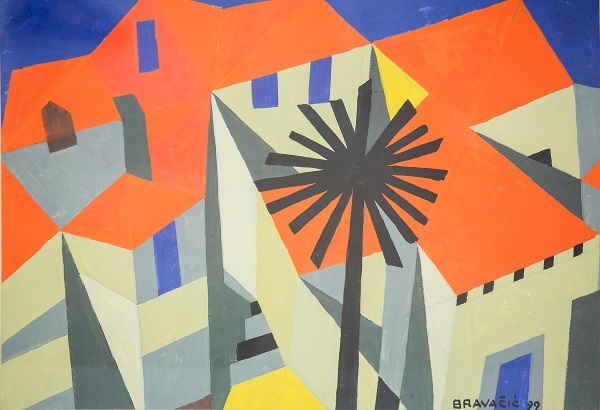
Stefan Braco Bravačić was in all his work a constant quester after harmony, but this in no way means he was a mere backward-looking aesthete. Harmony here refers to his activity as a connoisseur in determining and moderating the distinctive features of the beautiful and the category of the artist in various fields of expression. In all that he created, and he used various techniques to express himself, Bravačić aimed at consonance and a unity of perceptions, whether we are thinking of a musical theme or a composition in painting.
Vesna Delić Gozze
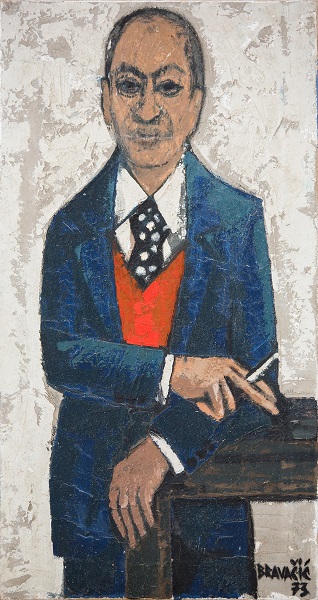
This creative artist’s visual procedure is the fruit of dedicated studies of objective reality, which were favoured by the engineer’s spirit of a trained architect and building. The geometry and reduction of surfaces indicate the need to see the essential structural determinations of life, their brio and buoyancy and their multifariousness point to the complexity of life and its situations, while the cross sections obtained by the juxtaposition of surfaces are resolved through a clearly executed geometrical panorama. Projected into the observer’s spirit, a visual panorama deployed in this way offers point and reason for existence to every individual detail in the field of the larger, decorative unit.
Milica Bravačić
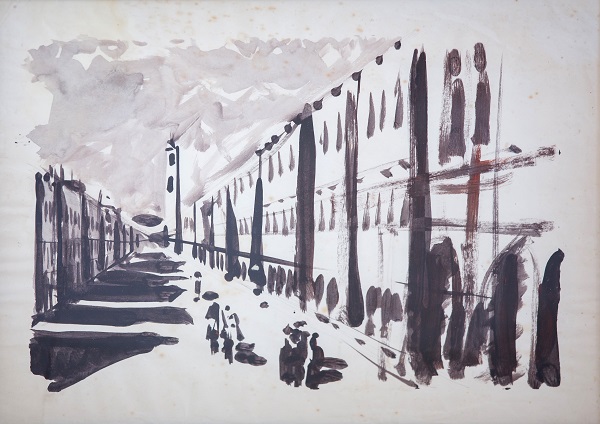
If anyone can be called a Universal Man, it was Braco Bravačić. Independently of his possession all the knowledge, the curiosity, many-sidedness, culture, talents and habits of industry of Renaissance man who soared aloft and could do everything – he also created his own world, to which he remained loyal to the end.
Jagoda Buić
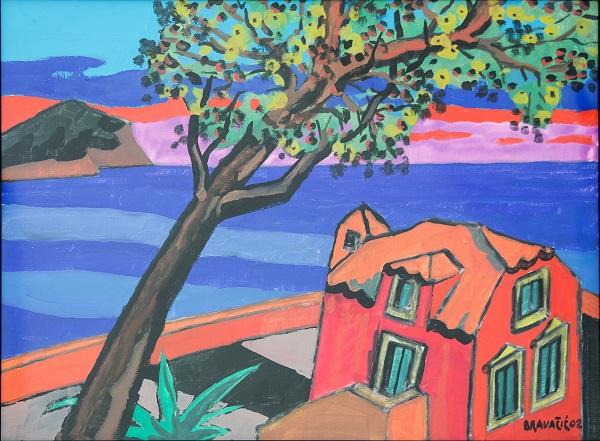
BIOGRAPHY:
Stefan Braco Bravačić, 1926-2013
After primary and secondary schools in Dubrovnik, he studied drawing and watercolours with the teachers Samojlov and Strala, and in 1954 took his degree at the Architecture Faculty of the Engineering Polytechnic in Belgrade, taught by Nikola Dobrović. After successful engagement with urban design approaches with a group of young colleagues from the faculty, with whom he won competition prizes, he went to Sarajevo, where he worked as architect, furniture designer, book designer, exhibition and commercial premises designer. In 1959 he returned to Dubrovnik with his family, and worked as a designer in the firm Arhitekt, and then as a freelance artist and member of ULUPUH, the applied arts association, on the designing of catalogues, prospectuses and posters, all the while also engaged on painting, architecture, shipbuilding and musical composition. He dedicated his creative and innovative spirit in those years to printmaking, constructing his own presses for his works in linocut and then in serigraphy. He had his first solo show in 1964, and then took part in group exhibitions. He became a member of HDLU, the fine art association, in 1971. But he was still vigorously engaged in urban design, architecture and painting. In 1981 to 1985 he did a Stanford, USA, correspondence course in yacht design, and on graduation acquired the qualification of yacht architect His second solo exhibition in 2001 in the Stradun Gallery in Dubrovnik showed works in tempera, after which came one-man-shows in the same exhibition venue in 2006, when he showed paintings in bright acrylics, and in 2009, when he exhibited new works in collage. Prints, oil paintings and other pictures created during the long and fruitful career of this artist are to be found in private ownership in Europe and America. In 2010 he took part as composer and performer in the Croatian selection for the Eurovision Song Contest, getting into the finale with his composition Tulip Trio.
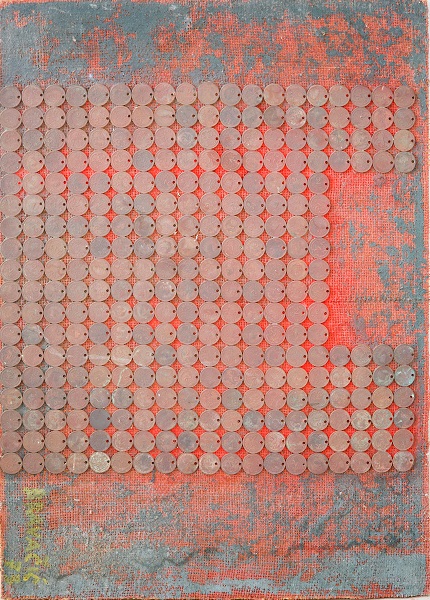
FRIENDS
Artist: Pietro Boban
3.8. - 21.8.2016.
Author: Andrija Seifried
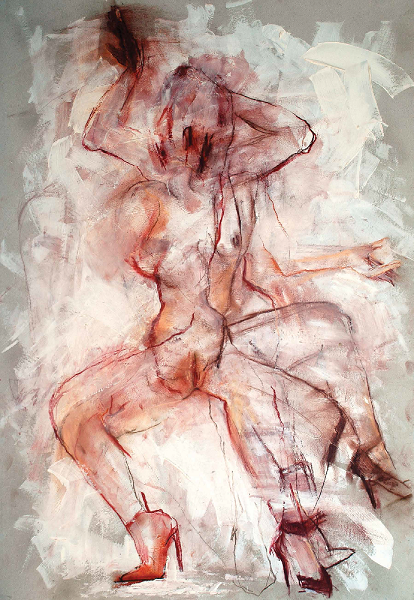
This exhibition in the Dulčić-Masle-Pulitika Gallery reveals a totally new Pietro, but one who has remained true to his creative élan, developed and built up during his years at the Academy of Fine Arts in Zagreb to a point of some perfection.
Andrija Seifried
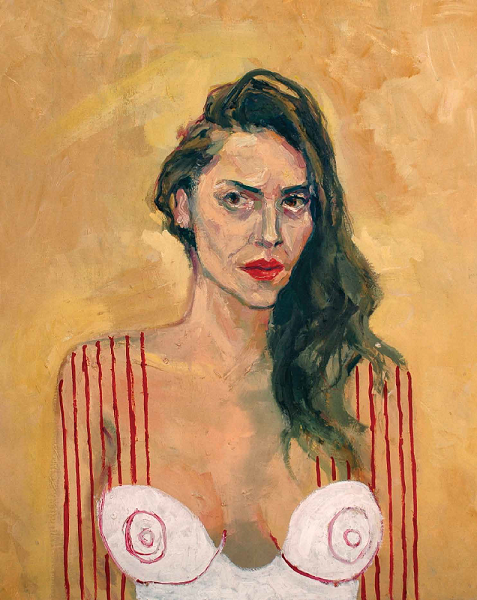
PIETRO BOBAN
Pietro Boban was born on April 7, 1991, in Dubrovnik. From very tender years he showed an interest in art, and subsequently enrolled in the Luka Sorkočević Art School in Dubrovnik, painter designer major. He had his first lessons from the painters Lukša Peko and Josip Trostmann. He exhibited at a number of collective shows during his secondary school education. He took part in the collective exhibition Orlando’s European Routes in the project of the same name of Dubrovnik’s Europe House. He represented his school at the 11th state competition – the exhibition of secondary school children being educated in fine and applied arts and design.
His first one-man show, Nudes, which was organised by the well-known Dubrovnik collector and art figure Andrija Seifried came in Dubrovnik in 2010. Since then Boban has remained loyal to the task of exploring the human body through the nude. In 2010 he enrolled in the Academy of Fine Arts of Zagreb University, painting major.
During his academy years, he was vigorously engaged in set design and set painting, mentored by Zlatko Kauzlarić-Atač. His set design continued under the mentorship of Tanja Lacko. During his student years he worked on many projects and exhibited in group shows; he was one of the organisers of the student art initiative ArtiParti. He has produced and assisted in the production of many set designs and projects.
As a young artist, Pietro Boban continues his vision of the world in his unique experience of reality, devoting particular attention to details in the creation of every work. In 2014 he won the Rector’s Special Prize as coordinator of the set design and set painting in the joint project of art academies for Gluck’s opera Orpheus and Eurydice, and a Rector’s Special Prize in 2015 for the artwork of the project 147 Seconds for Kenya. As set designer, he was part of the FRKA project team that was awarded the Rector’s Prize in 2015.
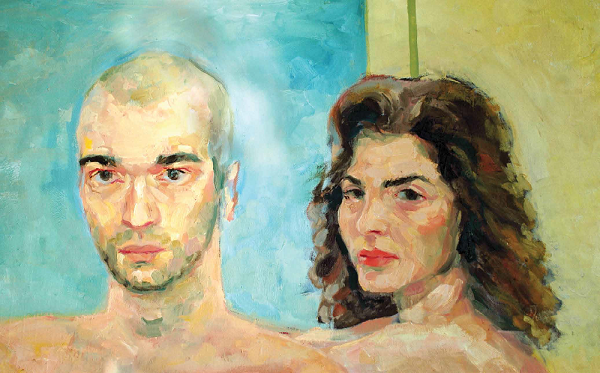
DUBROVNIK
29.7. - 2.10.2016.
Author of the exhibition: Vesna Delić Gozze
Authors of the texts in the exhibition catalog: Tonko Maroević, Vesna Delić Gozze, Irina Subotić, Ivana Udovičić

Edo Murtić
The presence of a canon, of a standard in the culture that has been handed down to us, amply explains the wonder that the inheritance of Dubrovnik has so generously provided. Measure and scale, the canons of this city, are a parameter according to which, as far as circumstances have admitted of it, the authors of this exhibition have endeavoured to move, in their selection of authors of the exhibits and the degree to which their works are represented. The City as mythic place of meaning, a corpus set aside for living and contemplation, for getting in touch with one’s own thoughts and feelings, is that produces a particular kind of comportment by fellow citizens, by constant and occasional visitors, a point that as the ability to attract old and new travellers, above all because of the layers of urban traces in consonance with their surroundings, adjusted to each other to such an extent that the synergy is as it should be. The city, with streets like pores cut into the stone cubes of houses and with squares that are teh stage settings for the gathering of one’s own thoughts, offers signs of differing times, tells of the cultural landscape that has graced this city for centuries.
Vesna Delić Gozze

Đuro Pulitika
Staging Dundo Maroje, a comedy located in a foreign setting, Marin Držić addressed his fellow citizens the rhetorical question: Does it seem a miracle to you to look at Rome from Dubrovnik? It seemed a good idea on this occasion to paraphrase, or actually, to invert this celebrated query and to apply it to the exhibition that will bring together paintings created very close to the exhibition venue itself, paintings that have the wish and ambition to present their view of the very setting in which they are shown. Does it seem to you a miracle to look at Dubrovnik from Dubrovnik?, then, suggests the undisputable making-strange of the effect of the same or similar motifs and views being seen in such different, frequently even disparate, manners. Our wonder at the richness of the creative seeing of Dubrovnik’s streets and squares, facades and roofs, greenery and gardens is a kind of affirmation of the accumulated beauty and complexity of the City, a confirmation of the felt harmony of outstanding cultural attainments and natural conditions.
Tonko Maroević
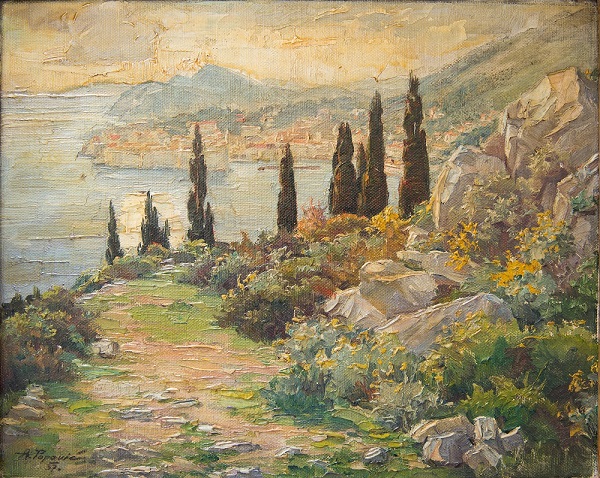
Atanasije Popović
If, using the example of just two painters, Petar Dobrović and Predrag Peđa Milosavljević, we cast a glance at their vision of Dubrovnik, we will sense the huge richness, as well as the differences in approach. This also tells of the enormous and extraordinary strength of Dubrovnik as visual and spiritual spur to creativity in all the disciplines, most of all, probably, in painting.
Irina Subotić
, 1934..jpg)
Petar Dobrović
Artists began to show the greatest interest in Dubrovnik in the first decades of the twentieth century, at the same time as the development of Modernism in these areas. It became a kind of informal artists’ colony, which occupied an important place in the biographies of a number of painters, but at the same time created a fertile ground for the origin of a home-grown art scene.
Ivana Udovičić
VLADO MARTEK
RECOLLECT LIFE
24.6. - 31.7.2016.
Curator: Vesna Delić Gozze
Authors of the texts in the exhibition catalog: Mikica Maštrović, Vesna Delić Gozze
In cooperation with National and University Library in Zagreb
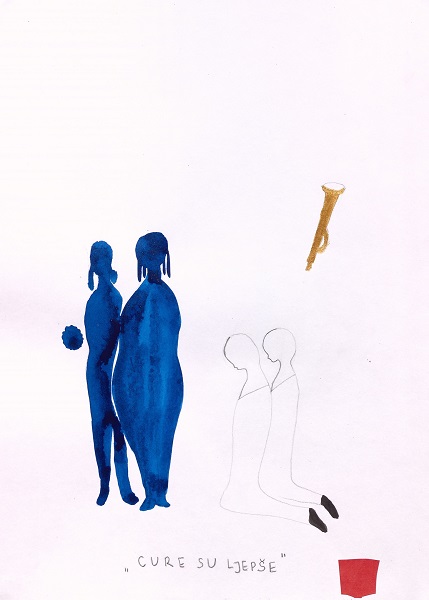
BIOGRAPHIES
Vlado Martek
Poet, conceptual artist, painter and essay writer, Vlado Martek was born in 1951 in Zagreb. In 1976 he took a degree in literature and philosophy from the Faculty of Humanities and Social Sciences of Zagreb University. At the beginning he was engaged with visual and concrete poetry, given the name pre-poetry, and from the middle of the seventies, with conceptualism, actionism with the Group of Six Authors, artist books and out prints (22 samizdats, leaflets, posters, picture postcards). From the beginning of the eighties he was into painting, sculpture, printmaking and land art. He wrote texts about poetry and texts and critiques about artistic practices. In recent time he has returned to projects in the spirit of conceptualism. He has published fifteen books, including collections of poetry and collections of texts and staged photographs, books of essays about contemporary art, six print portfolios and two co-authored editions of print portfolios. In 2002 a monograph by Miško Šuvaković was published, entitled Martek – the Fatal Figures of the Artist. In 2008 he had a retrospective exhibition in the Modern Gallery in Zagreb and he has had solo shows in Prague, Berlin, Paris and elsewhere. He is a member of the Association of Croatian Writers and also of the Croatian Association of Fine Artists. He lives and works in Zagreb and Rovinj.
His works are to be found in museums, for example, the Viennese Museum of Modern Art of MUMOK (Museum moderner Kunst Stiftung Ludwig Wien), the Museum of Modern Art in New York or MoMA, the Museum of Contemporary Art in Krakow (Muzeum Sztuki Współczesnej w Krakowie – MOCAK), in the National Museum of Contemporary Art in Athens or EMST, the Museum of Contemporary Art in Nîmes (Carré d´art – Musée d´art contemporain), the Parisian National Museum of Modern Art (Centre Pompidou – Musée national d'art moderne), the Museum of Contemporary Art in Zagreb, and elsewhere.
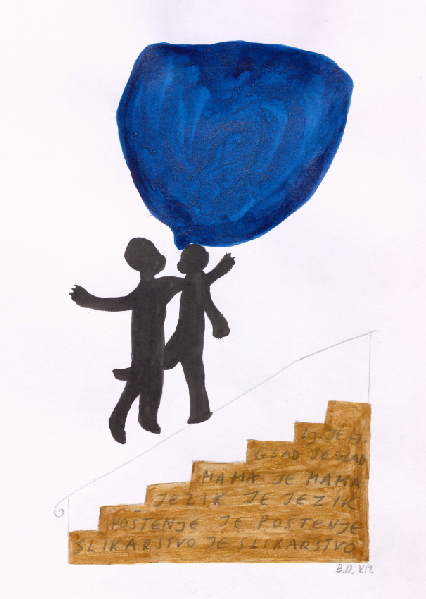
Boris Demur
The painter, conceptual and multimedia artist Boris Demur (Zagreb, 1951 – 2014), when he had finished high school, enrolled in 1970 in the Academy of Fine Arts in Zagreb, where he took his BFA in painting in 1975 in the class of Raoul Goldoni. In the same year he enrolled in a further, fourth, year in printmaking in the class of Albert Kinert, and took his degree in 1977. As painter, conceptual and multimedia artist, performer and theorist, he exhibited at ninety one-man shows and took part in more than two hundred collective shows and curatorial concepts. From 2001 to 2007 he was mainly engaged in the founding and work of Group 3/6 (Demur, Jerman and Martek). Many remember him from the last great exhibition in the Art Pavilion in Zagreb, from December 15 2013 to January 5, 2014, entitled Boris Demur: A Spiral Journey.
Spiral painting is a spiral natural event, simple and truthful. The spiral motif is in effect a natural process, but this process became the method of my painting...
Through my art, I endeavour to set free the banked-up cosmic being in myself. I see in this the reason for art, feeling and experiencing painting as prayer.
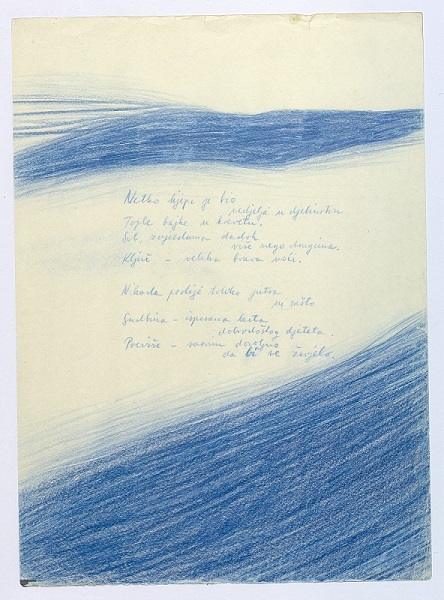
MILISAV VESOVIĆ
A LOOK BEHIND
24.6. - 31.7.2016.
Curator: Vesna Delić Gozze
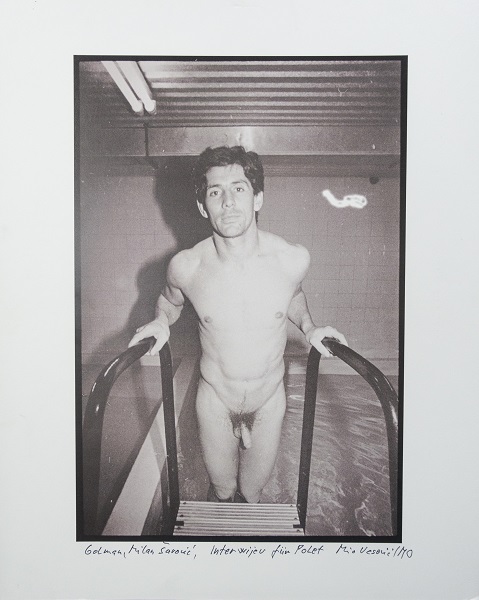
Restrained in his appearance, penetrating behind his lens, that is the portrait of Vesović, Veso, as I remember him, my view of the photographer’s personality. He held back in everyday reactions, which left time for the studied but never ultimately belated record of the reality that this photographer transformed into his own interpretation with an arsenal of small but lethal weapons contained in the lenses of his camera. Analyst in his approach to the subject, Vesović with the rare capacity of the creative artist synthesised what was seen into a photographic image of condensed semantics. Irrespective of the motif – portrait study, nude or scene from the street, the Vesović signature is always recognisable, but never obtrusive, a ‘fine diversion’ of a thoroughbred but never strident author whose camera is a means for the recording of the poetics of harsh and dry, as would have sung, had he dealt with photography and with light, the great Ezra Pound.
Vesna Delić Gozze
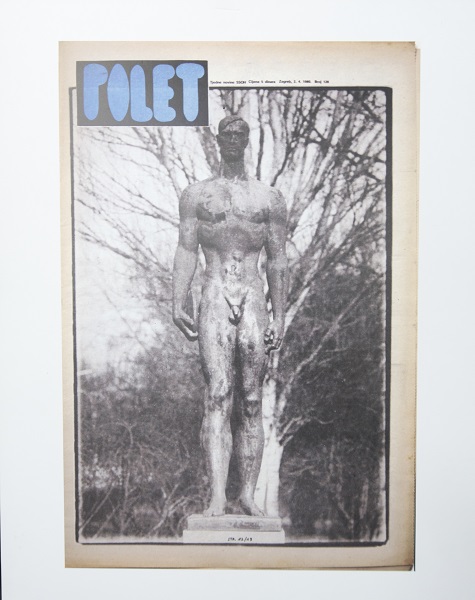
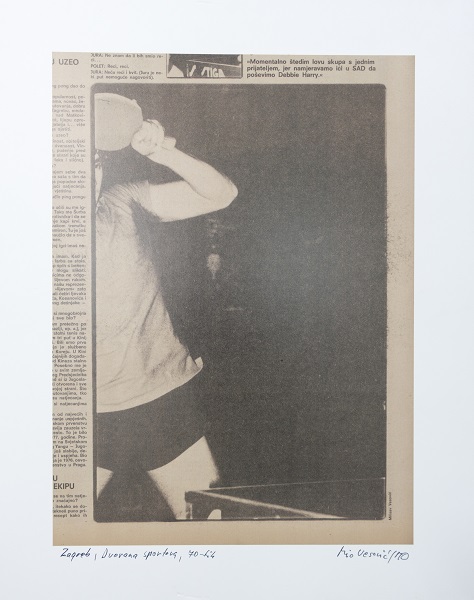
Biography:
Mio Vesović was born on the 24th of March, 1953, in Gornja Dobrinja. He studied under Nikola Tanhofer and graduated with a degree in Cinematography from the Academy for Theater, Film and Television. Since 1976, Vesovic has been working as journalistic photographer. His work has been published in all of the most important newspapers and magazines in the region. He founded the artistic studio MO (Mekano Okidanje, or Soft Shooting) in 1979 together with Ivan Posavec. Vesović and Posavec photographed and designed 150 covers for the magazine "Danas".
As a still photographer, Vesović worked with the following film directors: Rajko Grlić ("In the Jaws of Life", 1984), Veljko Bulajić ("The Promised Land", 1985), Zoran Tadić ("Dreaming the Rose", 1986). He received a credit for Special Photographic Effects on Dušan Makavejev¨s "Manifesto" (1987).
Vesović¨s works of photography are part of the following collections: the Museum of Modern Art, the Museum of Arts and Crafts, and the Modern Gallery in Zagreb; and Split¨s Art Gallery.
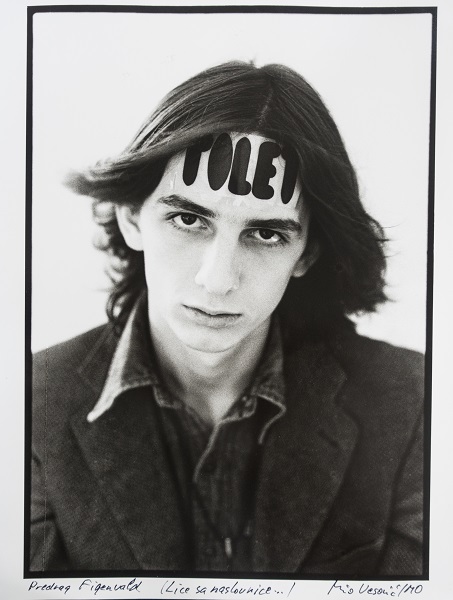
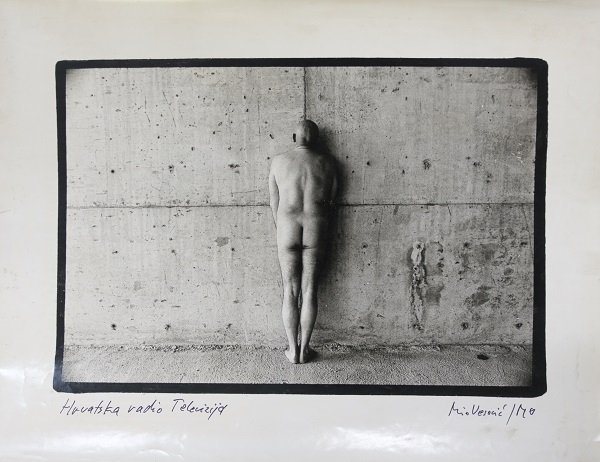
OD KRKA DO GALAKSIJA
MILA KUMBATOVIĆ
retrospective
2.6. – 24.7.2016.
Author: Ivanka Reberski
The exhibition OD KRKA DO GALAKSIJA MILA KUMBATOVIĆ retrospective has been open on June 2nd at Museum of Modern and Contemporary Art Dubrovnik.

ŠKOLJ SV. MARKA U NEVERI – REKVIJEM ZA ŠKOLJ, 1965. -1976., ulje, kolaž na platnu, 116 x 181 cm, privatno vlasništvo

VRŠIDBA NA KRKU, do 1948., ulje na platnu, 100 x 73 cm, Umjetnička galerija Dubrovnik
BIOGRAPHY
1915 June 17, Mila Kumbatović was born in Omišalj, island of Krk, to a seafaring family. 1927 She moved with her family to Zagreb, and after that lived and worked in this city. 1934 Enrolled in the Law Faculty of Zagreb University, soon dropping out however. 1945-1940 Studied painting at the Academy of Fine Arts in Zagreb (taught by Babić, Mujadžić, Kljaković, Krizman, Hegedušić and Tartaglia). 1940-52 After her degree, she taught art in secondary schools in Glina, Sisak and Zagreb. 1952 She left teaching, and became a freelance artist. 1945 Marriage with the painter Oton Gliha, whom she had met at the Academy. 1946 Exhibited for the first time at the ULUH Exhibition. 1953/1954 Spent time studying in Paris and London; started the geometrical stylisation of the Krk urban agglomerations of Omišalj, Malinska, Jurandvor, Vrbnik and Bakar. 1956 A son was born, Milen. 1960/1961 Creation of the cycle World of Stone. 1975 In Sisak Steelworks, the first works of industrial sculpture were created. 1980-1985 In Samobor’s Kristal factory, created sculptures in glass.
1990/1991 A new cycle of Krk landscapes was created. 1993 Her son Milen was killed in an accident. 1996 A number of retrospectives in Zagreb, Rijeka and Split.1997. A new cycle of "Space Landscapes" was started. 1999 The death of her spouse, the painter Oton Gliha. 2002 On Vis island, a cycle of Vis landscapes was created; she put on an exhibition of glass in Zagreb. 2003 A big retrospective was held in the Klovićevi dvori Gallery in Zagreb, and a monograph was published. 2004 Mila Kumbatović died; she was buried in the cemetery in Omišalj, side by side with son Milen and husband Oton.
Sculptures in public by Mila Kumbatović are displayed: in front of and in the grounds of the Zagreb Fair; at the entrance to JANAF in Omišalj; in the Peščenica Culture Centre, Zagreb, where there is also a big mosaic; in front of the Haludovo Hotel in Malinska; in the Gredel rolling stock factory, and the Textile Machine Factory in Zagreb; in the sculpture park of the Croatian Academy Glyptotheque in Zagreb.

MRTVA PRIRODA S PJETLIĆIMA, 1953., ulje na platnu, 68 x 56 cm, Umjetnička galerija Dubrovnik

KRUŽENJE, RASPADANJE I SPAJANJE SATELITA I, 1997., ulje na platnu, 73 x 100 cm, privatno vlasništvo

KOZMIČKA FIGURA, 1978., čelik, željezo, 30 x 16 x 16 cm, Muzej moderne i suvremene umjetnosti u Rijeci
TANJA DEMAN
TALES OF SPACE
May 5th – June 19th, 2016
Curated by: Rozana Vojvoda, PhD
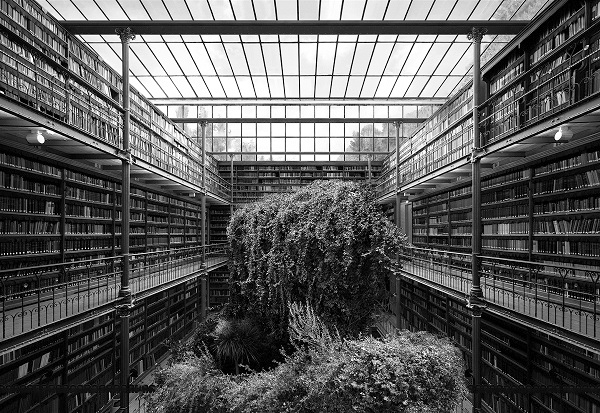
Museum Library
The exhibition «Tales of space» by Tanja Deman, organized by the Museum of Modern Art Dubrovnik has been open on Thursday, May 5th at the Gallery Dulčić Masle Pulitika and Studio Pulitika. Tanja Deman, whose work incorporates research into collective psychology and the perception of space, will present photo collage series Temples of Culture (2014), Collective Narratives (2013) and the video Abode of Vacancy (2011) which explore the structures and the areas of artificial and constructed vs. natural.
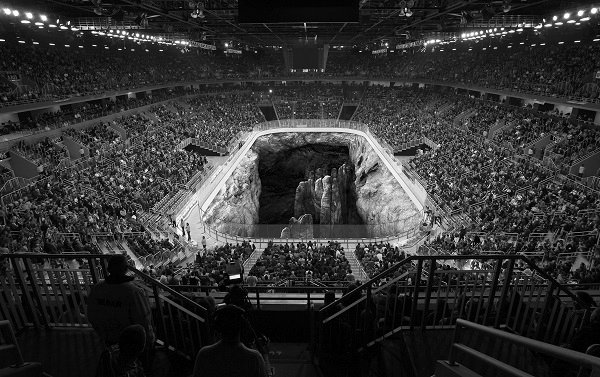
Arena
The Series Collective Narratives (2013) explores different types of spectatorship that include the ritual moment (sport and scenic spectacles) and their architectural settings transformed by the inclusion of natural element. The Series Temples of Culture (2014) examines different public institutions such as museums, libraries and galleries as they are decontextualized and given new version of their identity with a slightly ironic element. By inserting the natural element into spaces reserved for and dedicated to some human activity, Tanja Deman creates off-centre, hybrid worlds in which two differing contexts merge. One is the space of the collective act of looking, which presupposes an urban heritage, and the other is the contemplation of nature, which suggests being alone.
 Garden of Delight
Garden of Delight
Biography:
Tanja Deman's works, incorporating photography, collage, video and public art. She was born in Split, Croatia. She obtained an BFA and MFA at the Academy of Fine Arts in Zagreb. In recent years, her work has been exhibited in a large number of exhibitions including, Museum of Contemporary Art Zagreb; Kunstmuseum Bonn; Museo Revoltella, Trieste; Museum of African Design, Johannesburg; Danubiana Meulensteen Art Museum, Bratislava; The Central House of Artists, Moscow (CHA); MUNTREF Centro de Arte Contemporáneo, Buenos Aires; Museum of Modern and Contemporary Art, Rijeka; Pavillon Carré de Baudouin, Paris; Collegio Armeno - Palazzo Zenobio, Venice; TENT, Rotterdam; Unseen, Amsterdam; International Film Festival Rotterdam. She has also screened her work at a number of video and film festivals, including Videonale 14, Bonn; Kassel Documentary Film and Video Festival; Vidoex Zurich; Video Dumbo at Eybeam, New York City. She was artist in residence in Nirox Fondation in Johannesburgu, KulturKontakt Austria in Vienna, Atelierhaus Salzamt u Linz in Austria, Kunstlerhaus Saarbrucken and Oberfalzer Kunstlerhaus Schwandorf in Germany, and at the study trip at Indiana University of Pennsylvania, USA. In 2015 Tanja was invited to realise a large photographic public art project titled 'Sommerfreuden' which presented a wrapping of the Ringturm tower on Danube bank in the city centre of Vienna.
 Orchard
Orchard
UNCOVERING THE BODY
WORKS FROM THE MUSEUM’S COLLECTION
22.4. – 29.5.2016
Author: Petra Golušić
The works shown in the exhibition Uncovering the Body – Works from the Museum’s Collection tell of the human need for the representation of the naked body. They belong to the end of the 19th century, extend across the dramas of the 20th century and find their way into the most recent expressions. Included in the selection are 155 exhibits, some of them productions of foreign but mostly of local or Croatian artists, all of them taken from the collection of the Dubrovnik Museum of Modern and Contemporary Art. The selection includes works of painting, drawing, printmaking, sculpture and photography. Not included is the motif of the naked body that is applied within Christian iconography. All told, 45 artists are represented. The exhibition also features some of the works that are anyway part of the permanent display of the Museum – on the ground floor, the first floor and the terrace.
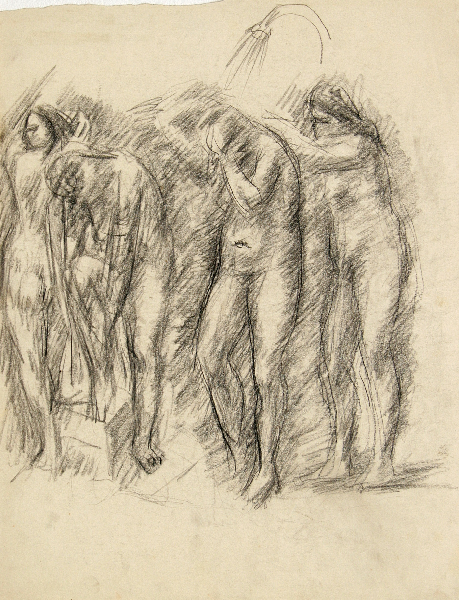
Gabro Rajčević, Under the shower, 1940-1943
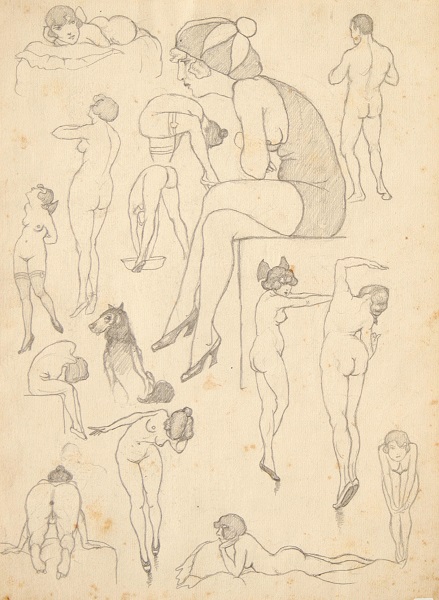
Andrija Maurović, Studies of dancers, 1923
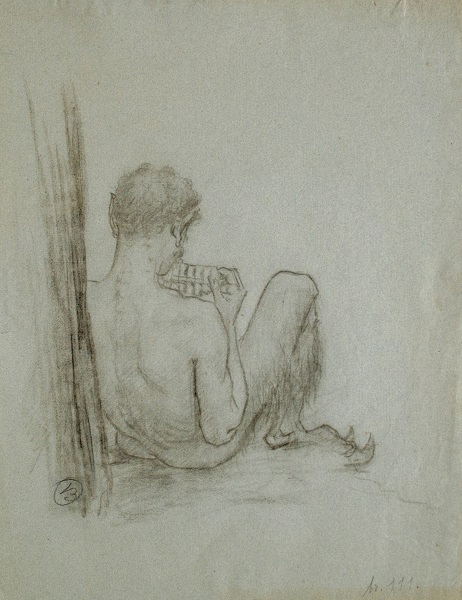
Vlaho Bukovac, Study of satyr
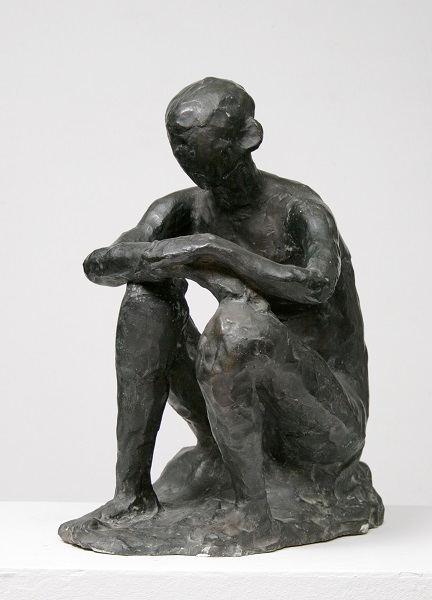
Ivan Kožarić, Sitting boy, 1955
The exhibition enables an insight into works whose individual styles record the sensitive character of the spirit that interprets itself through forms that are quite often deployed as central or totemic. A theme that mankind has found compelling since the beginning of visual creativity is being narrated. The uncovered body, or the just adumbrated body, is represented as that area of human perception that is basic, for it is the fundamental element of existence. The nakedness of the body is a metaphor that according to Heidegger exists only within metaphysics. Accordingly covert and codified meanings are represented, irrespective of whether we are concerned with some picture from Modernism or some contemporary idiom. /…/ Always concerned is some continuity of the interpretation of fragments of universal thinking, notions, visions and markers of the body being thereby created that belong to various creative practices. /…/ Artists who have had the courage create in their uncoverings of the body a special power of open expanses. Various depictions based on semantics, ideology and value judgement occur; the process of the liberation of the body creates an intriguing area of polysemous perusal./…/ A territory is created in which there is a clear statement of the continuity of the notation, signification, interpretation and paring down of - presence.
Petra Golušić
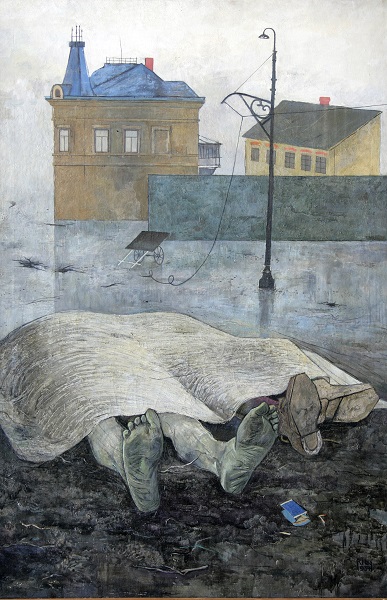
Krsto Hegedušić, Finale 1945, 1975
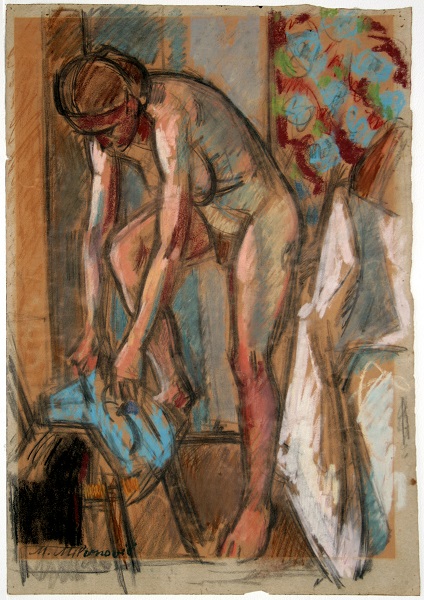
Milo Milunović, Female nude, 1950-1955
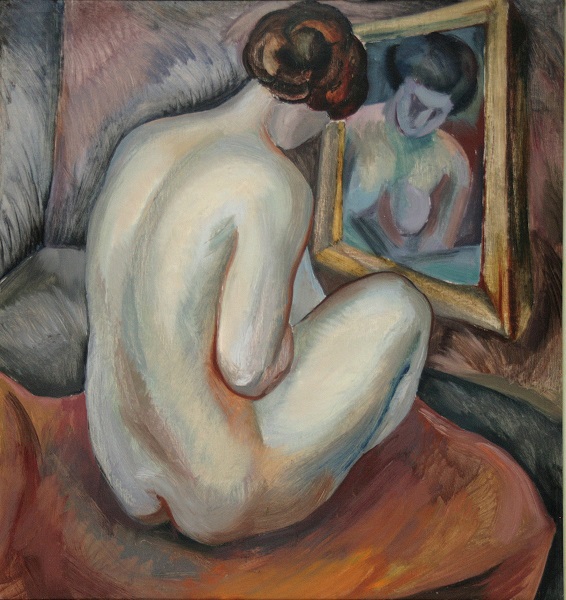
Roman Petrović, Female nude, 1929-1932
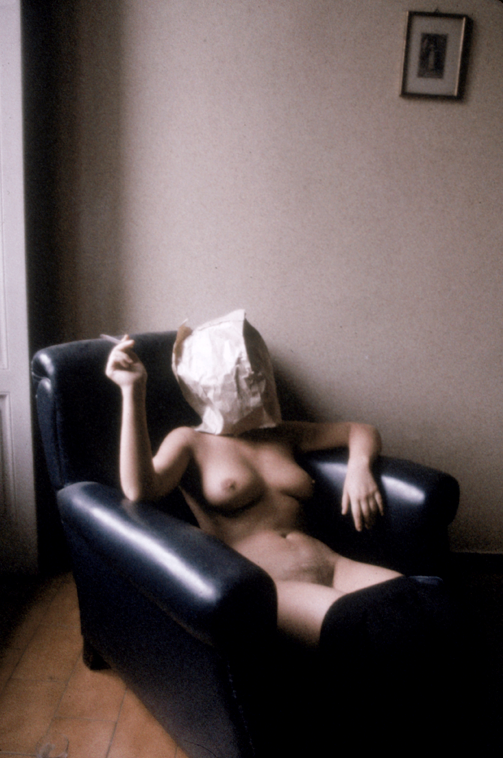
Robert Farber, No Model Release, Milan, Italy, 1989

Pavo Urban, Challenge, 1990
PLAKATI - SVJEDOCI MEŠTROVIĆEVA VREMENA
16th March - 1st May 2016
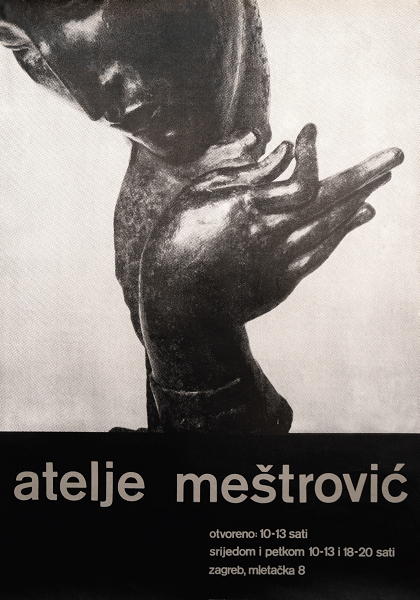
Ivan Picelj, ATELJE MEŠTROVIĆ, 1963.
.png)
Ivan Picelj, IVAN MEŠTROVIĆ, 1983.
Author of the exhibition: Lana Majdančić
.png)
Libor Fára, IVAN MEŠTROVIČ - 1863 – 1962 (1970.)
.png)
Mitja Koman, MEŠTROVIĆ, (1974.)
Artists at the exhibition:
Jure Amižić
Libor Fára
Mitja Koman
Slavoljub Lacković
Viktor Popović
Gorki Žuvela
IVO DULČIĆ
IVO DULČIĆ´S MEDITERRANEAN
11.2. - 17.4.2016.
Organisators: Museum of Modern and Contemporary Art Dubrovnik & Art pavilion in Zagreb
Autor: Tonko Maroević
Curator: Vesna Delić Gozze
The exhibition Ivo Dulčić´s Mediterranean, a retrospective exhibition by one the greatest Croatian painters, Ivo Dulčić has been open in Museum of Modern an Contemporary Art Dubrovnik on 11th February. The exhibition will be on view until 17th April.
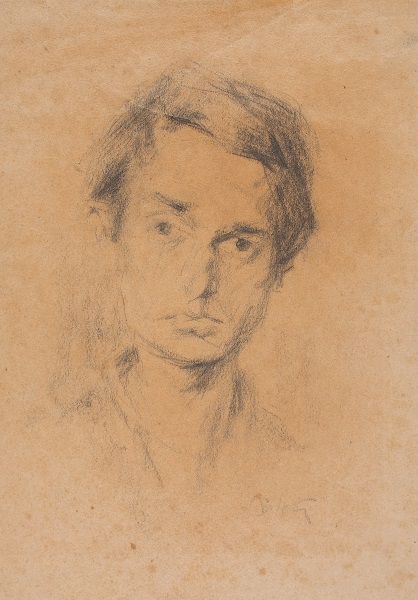
Self-portrait, 1944, charcoal
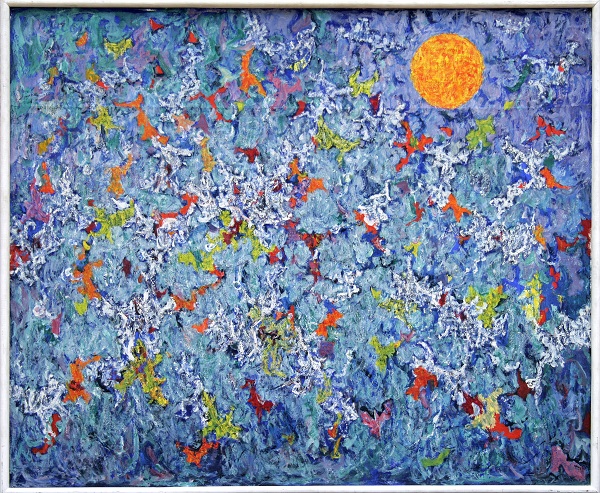
Dubrovnik Summer, 1956, oil on canvas

Stradun, 1950, oil on canvas
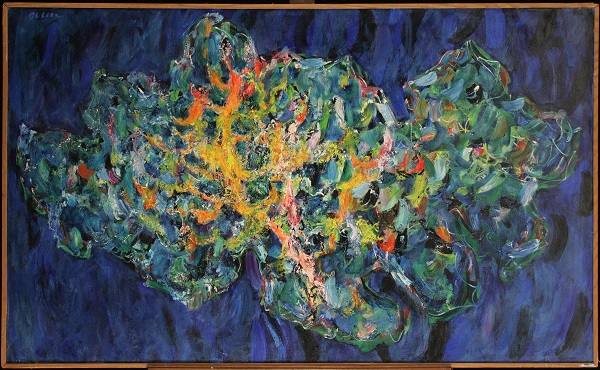
Fire on the Island, 1970, oil on canvas
From the first works, from the first lines, so to say, the first strokes recorded, it is possible to see Dulčić’s exceptional ability to see in terms of synthesis, to react vitally, never to adopt motifs apathetically, to translate them, in other words, into visual seismographs of high emotional voltage. In parallel with the acuity with which he fixed subjects in drawing, there also appeared very rapidly a highly emphasised sensitivity to colour, a marked openness to idiosyncratic chromatic solutions and specific tones from the edges of a broad palette. With both of these characteristics of his creative sensibility, the painter elevated every motif he presented to a new level of existence, augmented the intensity of its presentation and thus also ensured a rare coherence of a very personal approach.
Tonko Maroević

Church by the sea, about 1970, gvaš / gouache

Sea urchins, about 1965, tempera
The conflictive tension was evident from the start – it was his fountain of enthusiasm, of rapture and power, his feed of arts and his subjective truth. If expressionism requires and reconfirms that fatal identification, lyrical rapture, a permanent excitement of the psyche, the power of the earthly and the tragic and the steaming nervousness that kindles the vision, Dulčić then was the best medium for it. His passions, beliefs, answers, are written in the colour…
Antun Karaman

On the river, about 1955, gouache
From the intimism of the introverted observer, after his return to Dubrovnik in 1946, Ivo Dulčić first of all produced the shadiness of the atmospheres of stilled spaces. The painter’s journey, arising out of the intensive fever of the quest for accordance with motif, moved in the direction of the anthropomorphic treatment of ground as against figure, while the vibrant brushstroke created out of the painting compositions zones of conductivity and the orchestrated shimmering of the theme being interpreted.
Vesna Delić Gozze
A painter whose vigorous colours and directness were helping him to be both personal and lyrical, in the way to be able to reflect the dilemma of meditation and expression – subtly the former, more primordially the later.
Igor Zidić

Portrait of Antun Masle, 1965, oil on canvas
Biography:
Ivo Dulčić was born on August 14, 1916, in Dubrovnik, the ninth child (and first boy) in a family that had three years previously moved from Brusje, Hvar Island. In 1934 he graduated from the Dubrovnik Classics High School. During his school years he had gone in for poetry and visual art (he had published caricatures in occasional publications). After his graduation from school, in 1935 he enrolled in the Belgrade Law Faculty; while in Belgrade he boarded with his uncle, Sibe Miličić, poet and painter, but actually spent most of his time at home in Dubrovnik. In this period he was part of the circle around art critic Kosta Strajnić, in which he was able to get to know paintings of modern artists and books about art, as well as the painters themselves. In 1937 he transferred to Zagreb University, where he was ‘all but degree’ in law; in 1941, after a previous failed attempt, he managed to enrol in the Academy of Fine Arts in Zagreb. His teachers, Babić, Mujadžić, Hegedušić and Kljaković noted his talent and appreciated him highly. In 1943 he was mobilised, into what was called the culture battalion, in which he also painted and also socialised with colleagues and friends, particularly Kožarić, Jevšovar, Švertasek and Kinert. Immediately before taking his BFA in 1946 he got into a quarrel with Đuro Tiljak, a professor, and clashed with the champions of socialist realism. He quit the Academy and returned to Dubrovnik. For a time he ran a little painting school, in which many future painters (Stanić, Gusić, Grbić) had their first lessons. He spent a lot of time with friends from the “Dubrovnik circle”, the painters Antun Masle and Đuro Pulitika. In 1948 he exhibited for the first time at the collective exhibition of ULUH, Dalmatian branch (in Split and Zadar). His first solo show in Zagreb in 1950 was a hit. In 1951 he went abroad for the first time, visiting Venice, Florence and Rome in the company of artists. A considerable fillip to his reputation was given by the invitation from Ljubo Babić to exhibit his work in a group of selected pupils (along with Bulić, Mušić, Stupica, Tomašević and Nevenka Đorđević). In 1955 he bought a little flat in Zagreb, where he spent most of the year, never leaving Dubrovnik for good however. He regularly spent his summers in Lozna Bay, on the family holding on Hvar. After a second independent exhibition in 1956 in Zagreb, it was increasingly clear that Dulčić had an important place in modern Croatian art; for the first time he was included in selections of national painting meant to be shown mainly abroad. An important step in the making of his reputation was the publication of a small monograph by the publisher Naprijed (1958), written by Radoslav Putar, who had followed his work with particular empathy. In 1959 he ventured to produce the monumental fresco Christ the King in the Split Church of Our Lady of Health, thus starting an exceptionally valuable part of the religious part of his oeuvre. A new achievement in this context came in the stained glass windows for the Franciscan church on Zagreb’s Kaptol (1960-1964), a real masterpiece in this technique, completely exceptional in the contemporary setting. Having made his reputation as a colourist of a mainly Informel facture, with associative motifs on the very verge of abstraction, he made a turn towards the New Figuration in his eleventh solo show in 1965, exhibiting a number of inspired portraits. The same year he earned the City of Zagreb Prize; in 1968 he self-published a new small monograph, with a foreword by Matko Peić. In the last decade of his life he was extremely busily engaged on numerous tasks of a mural-environmental nature (in frescos, mosaics and stained class), mostly in churches, but also in various social premises, both at home and abroad. A retrospective exhibition was held in the Modern Gallery at the end of 1969 and early 1970. Ivo Dulčić suffered a short and grave illness and died on March 2, 1975, in Zagreb.

Interior, 1953, oil on canvas
BOGDAN BOGDANOVIĆ
THE DOOMED ARCHITECT
2.2. - 13.3.2016.
Organisator: Austrian Cultural Forum in Zagreb
Curator: Sonja Leboš
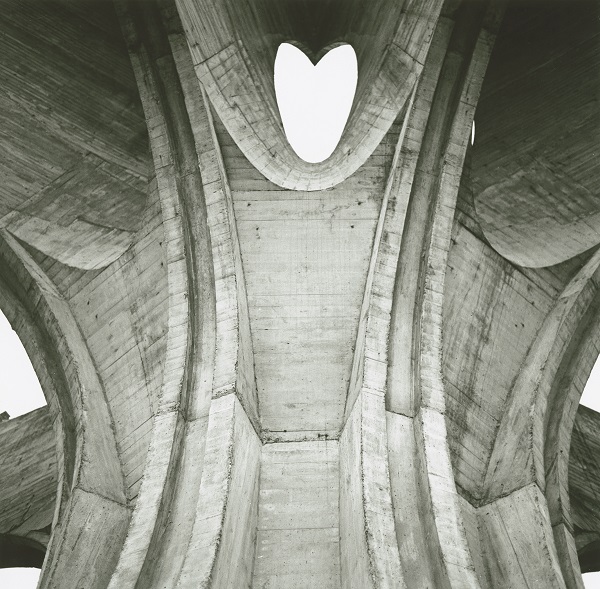
Bogdan Bogdanović (20 August 1922 − 18 June 2010) was a Serbian architect, urbanist and essayist. He taught architecture at the University of Belgrade Faculty of Architecture, where he also served as dean. Bogdanović wrote numerous articles about urbanism, especially about its mythic and symbolic aspects, some of which appeared in international journals such as El País, Svenska Dagbladet, Die Zeit and others.His main works are monuments built in the Socialist Federal Republic of Yugoslavia. In particular, the monumental concrete sculpture in Jasenovac gained international attention.
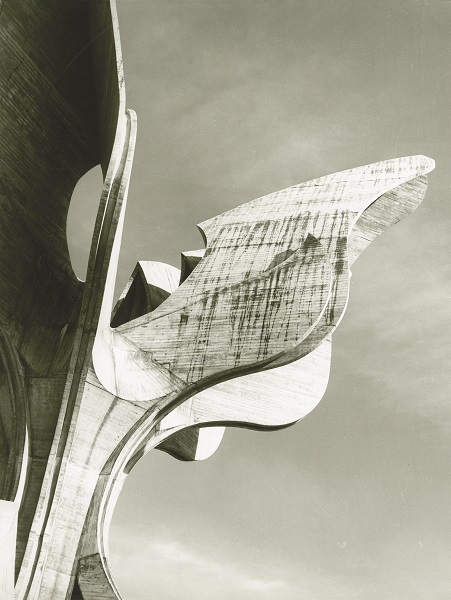
TINA GVEROVIĆ
SEA OF PEOPLE
15.01. – 07.02.2016.
Curated by: Rozana Vojvoda, PhD
Tina Gverović works with installation, drawing, painting, sound, text and video. Her work – often in the form of immersive, disorientating installations – engages with space, territory and identity and how these concepts are bound to imagination. She finished BA in Fine Arts at the Academy of Fine Arts in Zagreb in 1997, MA at Jan van Eyck Academy in Maastricht in the Netherlands in 2000 and holds a doctorate from Middlesex University in London in 2013. She recently showed work in Raum mit Licht Gallery (Vienna, 2015), Tate Modern (London, 2014), MSUB (Beograd, 2014), SE8 Gallery (London, 2013), and The Garden of Learning – Busan Biennial (Busan, 2012). She took part in residency programms in Sweden (Baltic Art Centre, Visby, 2012), Austria (Kultur Kontakt, Vienna, 2011), United States of America (ISCP, New York, 2006).
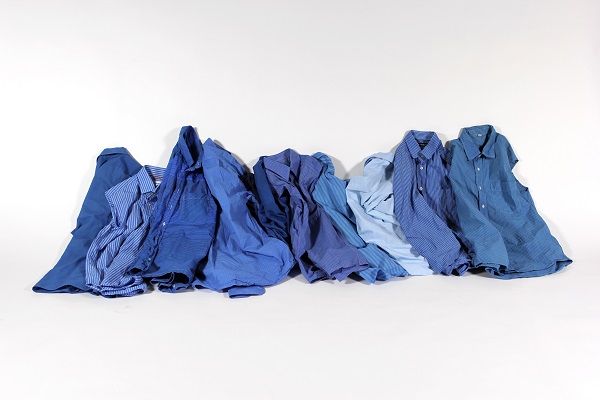
Inventory, 2016, installation with indigo dyed clothing and fabric
On Friday January 15th at 7 p.m. in the Museum of Modern Art Dubrovnik, Tina Gverović, Dubrovnik artist recognized nationally and internationally, opened solo exhibition entitled “Sea of people”. It includes the works that in a specific manner in an active relationship with the space of the Museum question the Mediterranean ambient. The idea of the Mediterranean that stems from her works is interwoven with the complex ideas of coastline, movements and migrations, interfusions that she problematises in different media – in the print, the painting, the installation,
video and audio works as well as in the form of the short story. The actual reading of some of the works is dependent on a complex relationship with the exhibition as a whole, which in its flow represents a journeying, a discovery process, the creation of a series of associations.
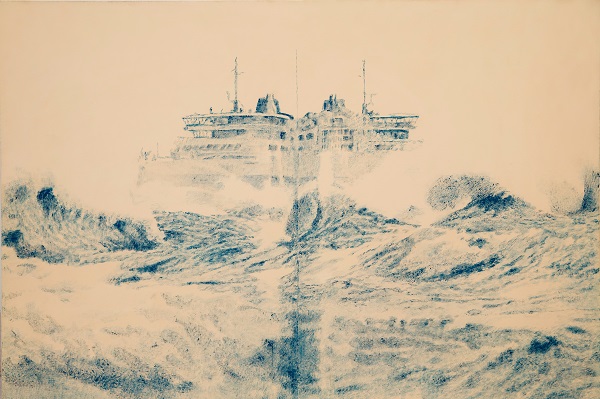
From the series of paintings Choose Your Time, 2007, acrylic on canvas
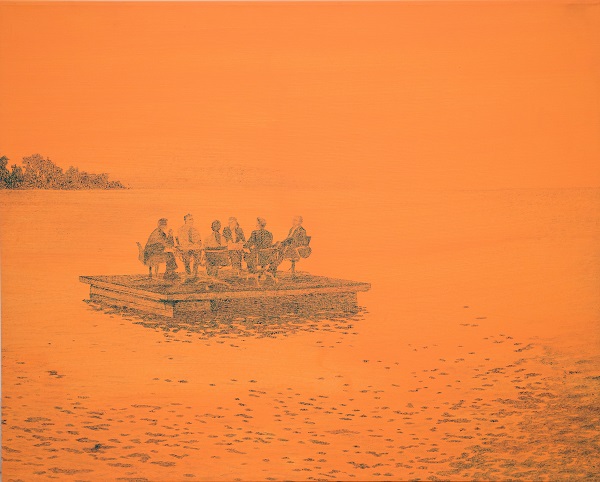
series of paintings At First Sight I-III, 2006, acrylic on canvas
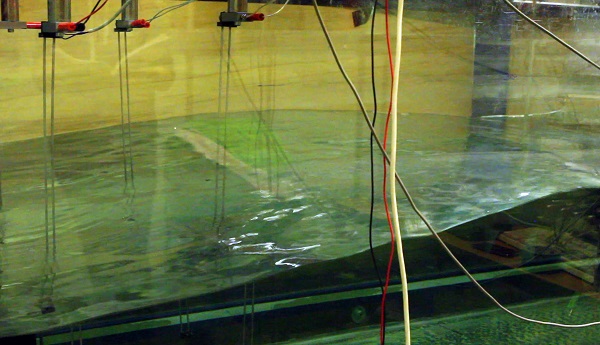
Testing the Waves I-II, 2016, video, HD loop
VANJA RADAUŠ (1906 – 1975): FROM LOVE TO DEATH
A Retrospective Exhibition Commemorating the 40th Anniversary of the Death and the 110th Anniversary of the Birth of the Artist
November 20th , 2015 – January 10th, 2016
Author of the exhibition: Davorin Vujčić, MA, Gallery of Antun Augustinčić, Klanjec
Curator: Rozana Vojvoda, PhD
An artist of both temperament and skill, Vanja Radauš was a creator of inexhaustible interests, he was learned and a fierce opponent in an argument, one of our most prolific 20th century artists. In this retrospective exhibition, the Dubrovnik Museum of Modern and Contemporary Art brings together a cross section of Radauš’s work; its opening in 2015 will commemorate the fourth decade since his death, and its close in 2016 the 110th anniversary of his birth.
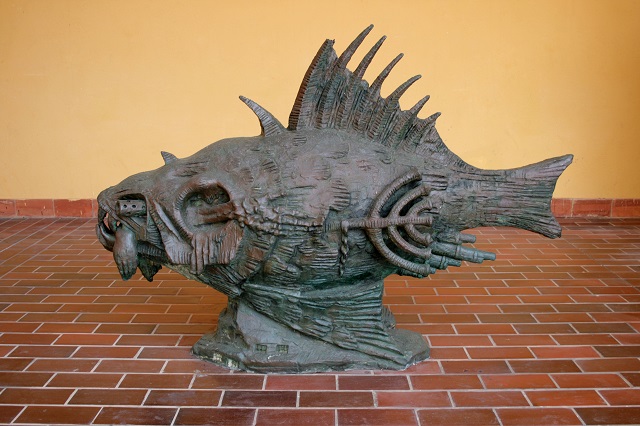
Fish (from the series Prisons and Camps), 1969, bronze
This exhibition numbers around 150 works (sculptures, medals, drawings) borrowed from a wide range of public cultural institutions (Municipal Museum Vinkovci, Gliptoteka HAZU, Archaeological Museum in Zagreb, Croatian Historical Museum, Croatian Conservation Institute, Modern gallery in Zagreb, Gallery Klovićevi dvori) as well as from the private owners. One of the curiosities of the exhibition is that some sculptures are represented to the audience for the first time.
The sculptures belong to all the phases of his oeuvre and include the works done in thirties and forties, post-war series Typhus Sufferers (1958), Panopticum croaticum (1959-1961), Man and Karst (1961-1964), Bloody Carnival (1965-1966), the abstract forms that appeared in Radauš’s oeuvre in the mid-60s, series Prisons and Camps that grew out of organic and abstract forms and the works from his last years when he revived his memories of childhood and Slavonia.
Vanja Radauš left a powerful mark on sculpture, in a range of genres and techniques including medals, small-scale sculptures in terracotta, plaster and stone, wax and bronze, as well as monumental sculptures. In his series of sculptures, he opened up vistas previously unknown and is with good justice considered one of the most significant figures in Croatian sculpture of the 20th century.
Biography
Ivan (Vanja) Radauš was born on April 29 in Vinkovci, where he spent his childhood. He studied sculpture at the Academy of Fine Arts in Zagreb from 1924 to 1930 (for the first four years he was taught by Rudolf Valdec and Robert Frangeš-Mihanović, from 1928 to 1930 by Ivan Meštrović). In June 1930 Radauš took his degree in sculpting and in the autumn travelled to Paris. Socially sensitive and committed, in 1932 Radauš took an active part in the Zemlja Artists Association, which was to have far reaching implications for his artistic development.
From 1940 – 1943, Radauš worked as a job as teacher at the Trades and Crafts School in Zagreb. When the World War II in which he was actively involved was over, Radauš became a part of the nomenclature [socialist Establishment], with appropriate roles and duties. In 1945 he was appointed professor at Zagreb’s Academy of Fine Arts (from 1954 to 1956 and from 1960 to 1962 he was the president of the institution, in 1963 its dean). In 1947 he became a regular member of the Yugoslav Academy of Arts and Sciences and was given the title master sculptor, and put at the head of the newly built master workshop for sculpture at Zmajevac in Zagreb. On April l27, 1975, he committed suicide in his office at Zmajevac, shooting himself with a pistol in the heart. The circumstances surrounding the act were not completely explained, which excited various interpretations and suspicions that are still alive today.








